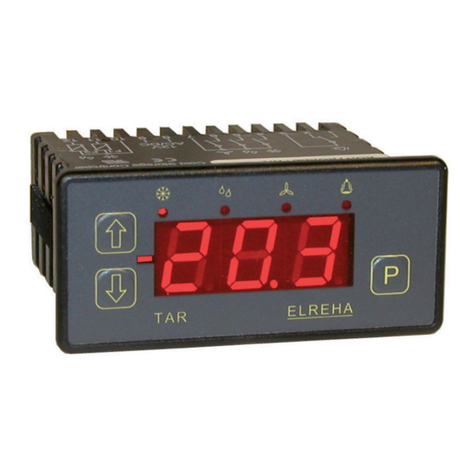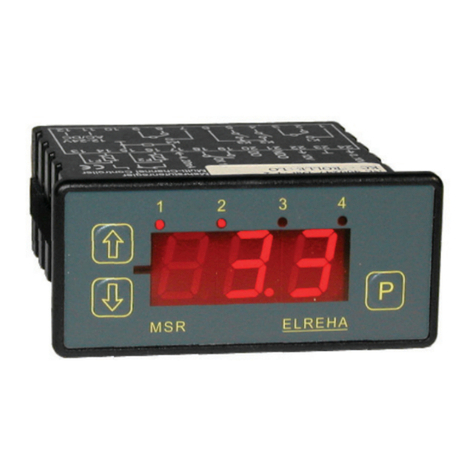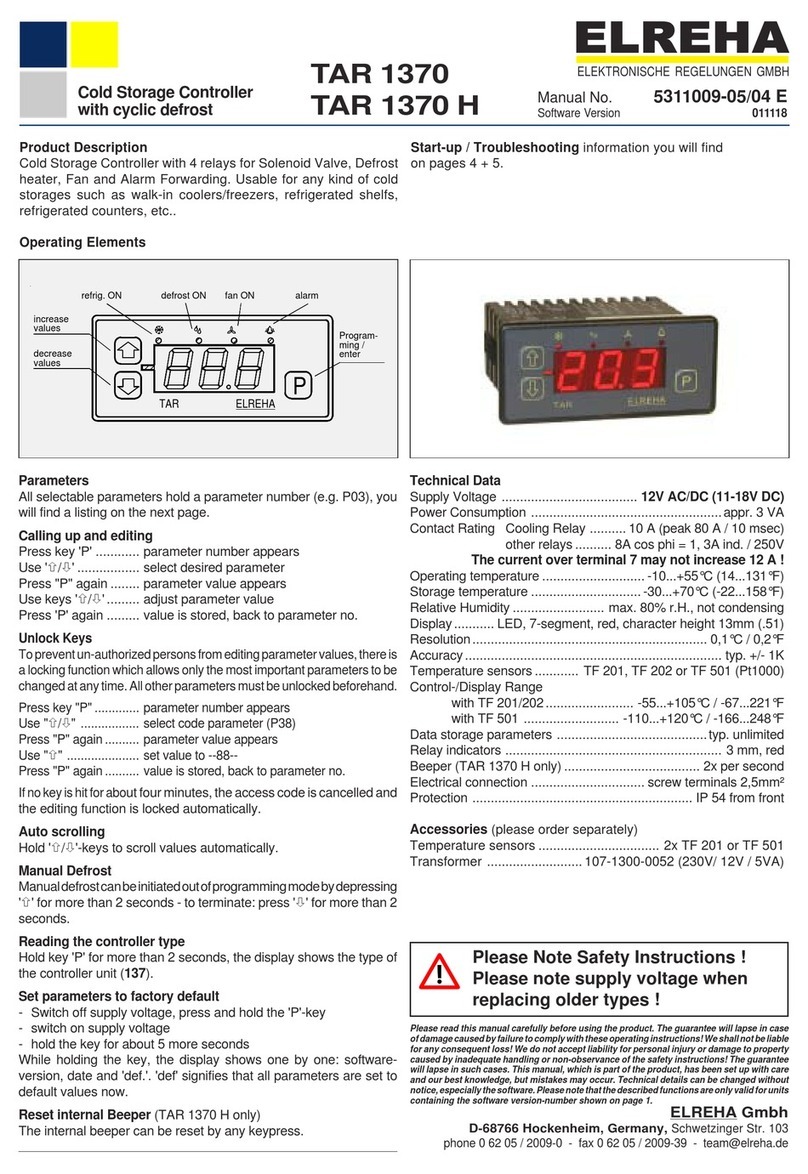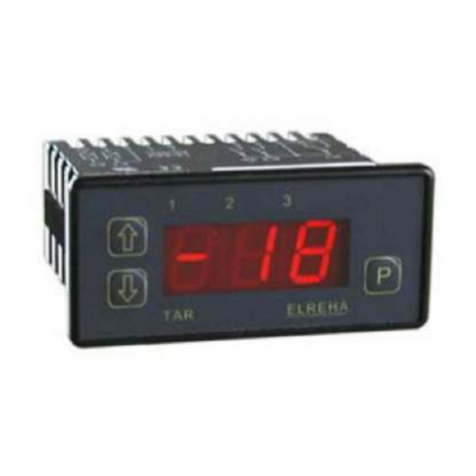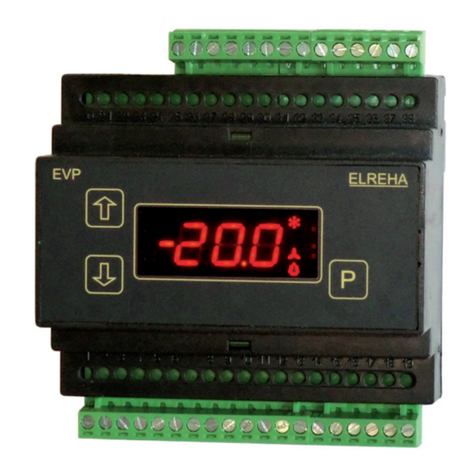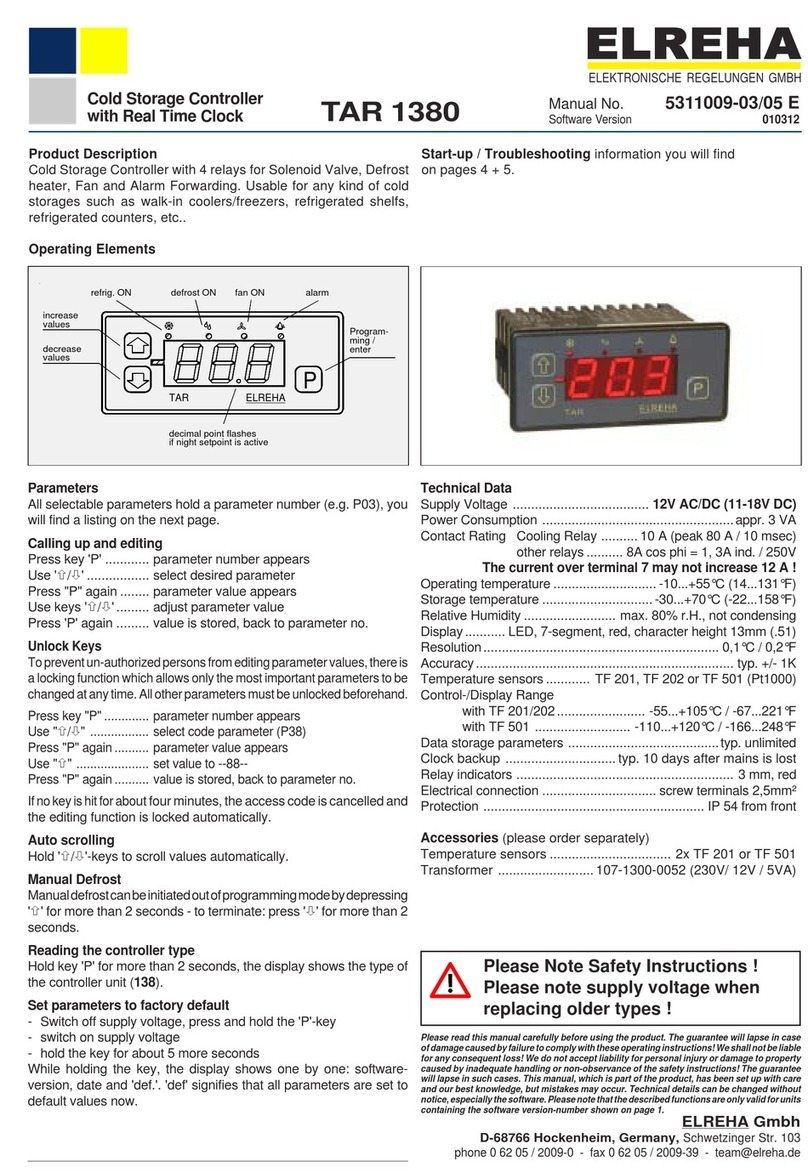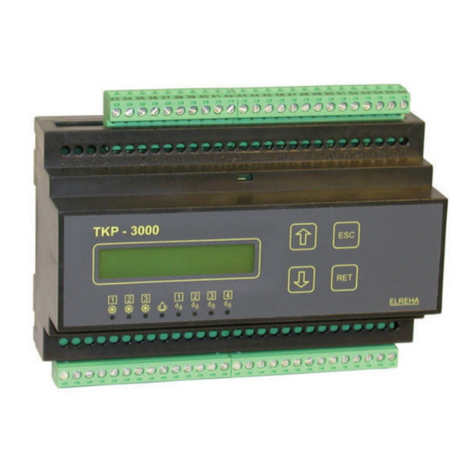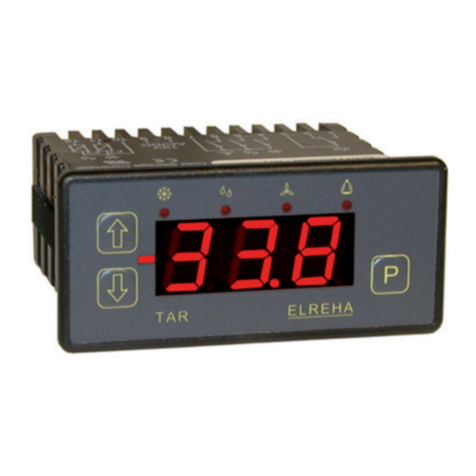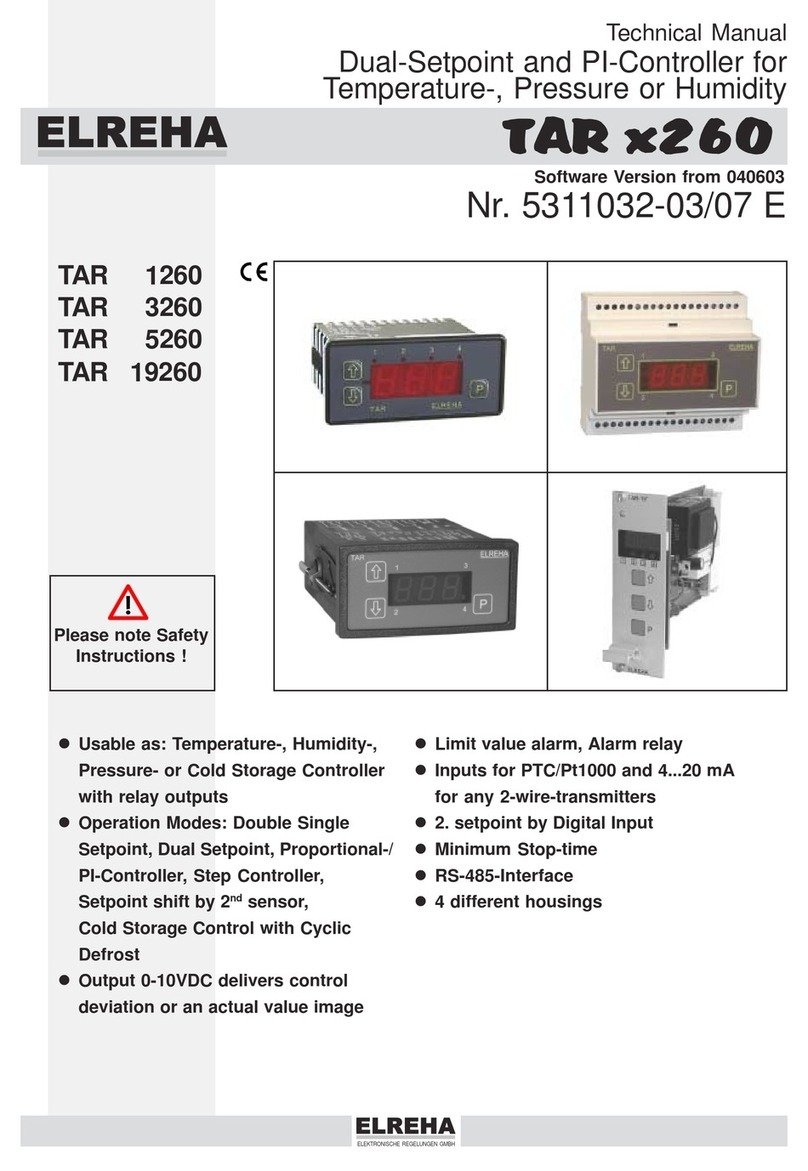
Technical Manual TAR x810-2 Cold Storage Controllers Page 5
Functional Description
Display & Sensors
The controller is able to work with temperature
sensors of the TF 201 or TF 501 (Pt1000) series,
set by P21.
Ranges:
P21 = 1 (TF 201).................... -50...+100°C
P21 = 3 (TF 501/Pt1000)....... -100...+300°C
Please note the specic temperature restric-
tions of the used sensors (e.g. -40...+80°C of
the standard-TF-types) and ask for matching
types if necessary.
Sensor 2 (evaporator sensor) can be disabled.
Temperature Control
Theactualtemperaturefromthecontrolsensor(P01)
is compared with the control setpoint (P03). Depen-
ding on the result, the cooling relay switches power
relaysofcompressors orsolenoidvalves.Aswitching
hysteresis (P09) prevents from short cycling, an idle
time (P11) prevents a compressor from switching
ON again immediately. In order to be fail-safe in case
of any internal power failure, there is a possibility of
selecting the correct switching mode (P10). In refri-
geration mode the N/O relay contacts are used so
that the load is shut off in case of failure. In freezing
mode the load is connected to the N/C contact, with
the load running constantly in case of failure.
Setpoint range
With parameters P07/P08 you can limit the setpoint
range.
Switching mode of relay K1
The switching characteristic of relay K1 (= cooling
mode) is dened by parameter P10 (as explained
above).
1= refrigeration
Load is switched by the N/O contact,
If actual value = P03+P09 : Relay K1 activated
2= freezing
Load is switched by the N/C contact,
If actual value = P03+P09 : Rel. K1 de-activated
3= Heating
If actual value = P03-P09 : Rel. K1 is now a
heating relay and will be activated
2. Setpoint / day-night-shift
To economize energy, e.g. at night, the unit is able
to work with a 2nd setpoint (P04). This setpoint can
be activated by the internal time-switch (P05/P06) or
the digital input DI1. The decimal point of the display
ashes while the 2nd setpoint is present.
Temperature alarm
Analarmrelay(K4)andabuilt-in buzzer areavailable
for warning purposes. If the temperature measured
by the control sensor exceeds the range set by
P32/P33, then the display ashes and a time delay
(P31) starts. After this timer is run down, the alarm
relay and the buzzer will be activated. P32 is relative
to setpoint P03, so P32 will be shifted the same
amount as the setpoint.
-- Any keypress resets the buzzer. --
If the temperature has left the range, P18 shows the
remaining time until an alarm occurs.
If the temperature comes back to the working range,
relay and buzzer will be reset automatically.
Alarm relay operation modes
With parameter P30 you select the mode of alarm
relay and internal buzzer:
0= Alarm relay active ON
1= Alarm relay active OFF
2= Alarm relay active ON, buzzer de-activated
3= Alarm relay active OFF, buzzer de-activated
4= Alarm relay works like the built-in buzzer, to
connect an external horn
5= Continuous ON of relay K4 if control setpoint 2
is being activated. Alarm messages will be
forwarded by buzzer/alarm-LED only. With this
function, light can be switched by time control.
6= Alarm relay can be switched via data interface
only. This works as well as the controller is de-
activated by interface or digital input. The swit-
ching command keeps stored, so the relay
position will be restored after a breakdown of
supply voltage.
Additionally, the alarm function can be started by
interrupting the digital input DI1 (see P34).
Real time clock
TheTAR ColdStorageController containsa realtime
clock which allows you to initiate four (8 with AZV)
defrost cycles a day. The timer has a power backup
for about 10 days in case of power failure.
The time of the day and the date can be set with
parameters P41...P45.
The defrost times are set with P24...P27 in 10 minute
increments in a 24 hour (military) format. Example:
13.20 = 01:20 p.m.
The second setpoint switch is made with P05/P06.
Because the display has only three digits, the time
value comes in the following format:
Switch times can be de-activated by setting to
'oFF'.
While the data recording function is active, time and
date cannot be adjusted.
To adjust the clock, rst de-activate data logger
(P39=0).
Defrost
One relay output is used to control a defrost de-
vice.
Defrost Initiation
A. by internal timer, four times available
(P24...P27)
B. by digital input DI1 (see chapter 'digital input').
In this case P35 will take effect as a 'defrost
OFF' time.
C. manually (P49).
The defrost device is always driven from the n/o
contact of relay K2. There is no need for external
interlocking the defrost output with the cooling output
since the temperature controller is disabled while a
defrost cycle. With P23 you can select four different
defrost modes.
Parameter P15 shows the remaining time of the
momentary defrost cycle until termination by time.
Defrost Modes
With P23 a defrost mode can be set, which works in-
dependent from the behaviour of the control relay.
1 = Heater or Free Air Defrost
If a defrost cycle starts, the defrost relay is
energized (= heater ON) and K1 terminates
cooling. (relay de-activated if P10=1, activated
if P10=2 )
2 = Hot Gas Defrost
If a defrost cycle starts, the defrost relay is
energized (bypass-valve open) and also K1
(solenoid valve open/relay activated if P10=1,
de-activated if P10=2 ).
3 = like 1, but with additional
defrost time doubling (AZV)
4 = like 2, but with additional
defrost time doubling (AZV)
Defrost time doubling (AZV)
This is a simple function to double the quantity of the
potential defrost cycles (4 --> 8). The unit generates
new defrost times automatically by adding 12 hours
to existing times.
Example:
If a defrost cycle is xed at 14:30, the unit starts
an additional cycle at 2:30 (am) without entering
this time.
3rd Position=
minutes x 10
1st and 2nd
Position=hours
Manual Defrost Initiation
A. At parameter P49 with key ""
B. While the display shows the actual
temperature by holding the "" key (> 2,5 sec.)
Defrost Termination
A defrost cycle can be terminated as follows :
A: Thermal termination.
Whenever the evaporator sensor temperature
(P02) exceeds the temperature limit set with
parameter P22, defrosting will be terminated.
If not necessary, switch off the evaporator
sensor at P20.
B: Termination by (safety) time.
The time set by parameter P28 is the
maximum time a defrost cycle can last before
it is terminated automatically.
C: Manual termination.
With parameter P49 you can terminate a
defrost cycle by pressing the "" key.
While the actual temperature (P01) is on the
display, a defrost cycle can be terminated by
holding the "" key (> 2,5 sec.)
D. If the defrost limit sensor fails, the defrost cycle
will be stopped immediately.
After the defrost cycle is terminated, the beginning of
the cooling function is delayed (P29). This prevents
freezing water drops on the evaporators surface.
P16 shows the remaining time until cooling starts
again.
(DH) Display Hold Function
This function allows to hold the last measured actual
temperature value on the display during a defrost
cycle. After the defrost cycle has been terminated,
the displayshows the current measuredvalue again.
The DH-function can be initiated by P50.
Evaporator Fan Control
Fourdifferentmodes offanoperationcanbeselected
with parameter P13.
A temporal fan-ON delay is active after a defrost
cycle (P14).
A thermostatic delay is always active. That means
the fan starts only if the temperature measured with
the evaporator sensor is 3K below the fan stop/go
temperature (P12). If this function is not desired, P12
can be set to its upper border to make it inefcient.
While the drain time (P29) the fan remains stop-
ped.
Fan Modes (P13)
1 = Fan runs if compressor output (K1) is on.
After defrosting the fan output is OFF until the
programmed Fan Delay Time (P14) is
complete. .
2 = Fan runs continously, except during defrost
and Fan Delay Time (P14) after defrost.
Thermostatic fan delay: The fan stops if the
temperature measured with the evaporator
sensor exceeds (P12). If this function is
not desired, P12 can be set to its upper border
to make it inefcient.
3 = Fan runs if the compressor output (K1) is on,
and during defrost.
The temporal fan delay must be set to "0".
This mode can be used for free air defrost.
4 = Fan runs permanently, except if unit is
switched off via interface.
(P17) informs about the remaining time until the fan
starts again.
Special case
If digital input DI1 is used for door monitoring, the fan
will stop immediately if the door opens.
Practical conditions
The fan is always switched by the n/o contact of
relay K3.
If you want to realize a thermostatic delay, select fan
mode 2and adjust setpoint P12.
If you want to realize a thermostatic delay and free
air defrost, please realize a parallel connection of fan
relay and defrost relay.
